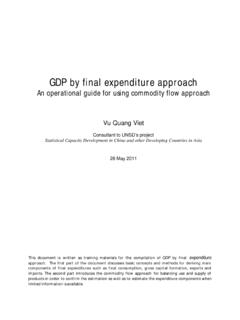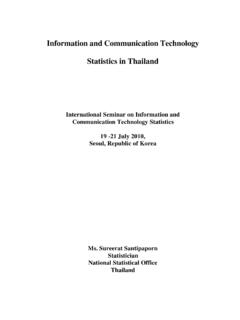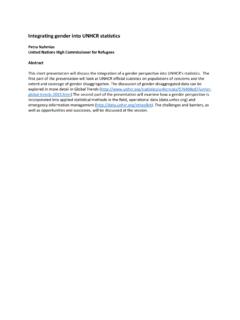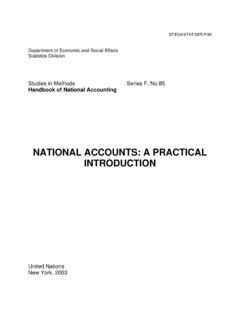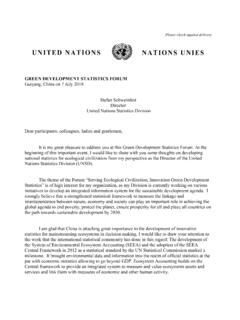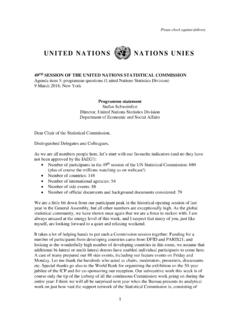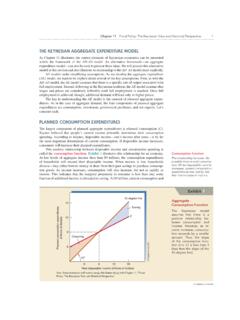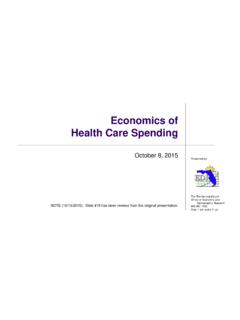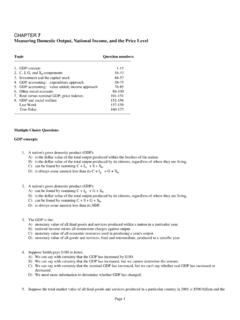Transcription of GDP by production approach - United Nations
1 1 | GDP by production approach GDP by production approach : A general introduction with emphasis on an integrated economic data collection framework Vu Quang Viet Consultant to UNSD s project Statistical Capacity Development in China and other Developing Countries in Asia Fourth revision 11 December 2009 This document is written as training materials for the compilation of GDP by the production approach . The document in the first part discusses basic valuation principle in national accounting and the links between it and business accounting. The second part discusses methods and practices in estimating value added by kind of economic activity. The third part discusses methods and practices in estimating final expenditures. The fourth part discusses an integrated strategy for economic data collection.
2 Finally the fifth part discusses double deflation method. The appendix contains exercises that readers should go through to master the basic concepts and practices in national accounting. 2 | GDP by production approach Table of Contents Methodological A. Three approaches to measuring GDP .. 4 B. Strategy to ensure consistency and reliability in GDP compilation .. 6 C. What approach is preferable? .. 6 D. Should the value added generated by both economic activities and institutional sectors be compiled? .. 7 E. Compilation and extrapolation of GDP: a note on technique .. 8 F. Strategy to raise public awareness on GDP 11 G. Focus of the 12 H. 14 Part I. GDP and valuation system in national accounting and links with business Chapter 1. What is GDP? ..16 A. Output at basic prices.
3 16 B. Intermediate 17 C. Operational definition of gross value added and GDP .. 18 D. Components of gross value 21 E. Examples of GDP compiled by three different methods .. 24 Appendix 1: Exercises on supply and uses of goods and services .. 26 Chapter 2. National accounting and business A. Some basic definitions in business accounting and national accounting .. 28 Sales/ revenues/values of 28 Transactions of goods and services .. 30 Property 30 Current transfers .. 31 Capital transfers .. 31 Capital gains and 31 B. Introduction to national accounts aggregates beyond 33 Appendix 2: Exercises on supply and uses of goods and services .. 34 Part II. Methods and practices in estimating value added by kind of economic Chapter3. Measurement of output and intermediate A.
4 38 B. Agricultural output .. 39 C. Output and intermediate consumption of industrial activities .. 46 D. Output of distributive 49 E. Construction .. 51 F. Output of financial intermediation .. 53 G. Output of nonfinancial services .. 60 3 | GDP by production approach H. Output of nonmarket 61 I. Output of goods and services produced for own 62 J. Output of originals and copies .. 64 Part III. Methods and practices in estimating final Chapter 4. Measurement of final A. Final consumption expenditures .. 66 B. Exports and imports of goods and 68 C. gross capital formation .. 71 D. Capitalization of own-account capital formation: an example .. 74 E. Estimation of gross capital formation .. 75 F. Estimation of consumption of fixed capital .. 77 G. Relationship between consumption of fixed capital, net capital formation, net saving and net value 80 Appendix Exercise on consumption of fixed capital and net stock of fixed assets.
5 81 Appendix Exercises on GDP by production and final expenditure .. 82 Chapter 5. An integrated strategy for compiling GDP by the use of the supply and use tables 85 A. Introduction .. 85 B. Description of supply and use tables (SUT).. 85 C. The use of SUT in compiling national accounts with limited information .. 87 Part IV. Collection of economic data to support national accounts Chapter 6. An integrated strategy for economic data collection to support national accounts .96 A. Introduction .. 96 B. Strategy for the development of data on nonfinancial market producers .. 97 I. Agriculture and the like .. 99 II. Corporations ..100 III. Households as productions units and statistical C. Measuring households unincorporated enterprises with market production (HUEMs).
6 104 Part V. National accounts in constant Chapter 7. Double deflation methods ..108 A. Introduction ..108 B. General Appendix Types of price indexes ..111 Appendix Examples ..113 Example 1. Double deflation when full SUT is Example 2. Double deflation when full SUT is not available ..117 Appendix The RAS method ..122 ANNEX. Solutions to 4 | GDP by production approach Methodological introduction 1. Economically, the gross domestic product (GDP) can be defined as the total value of goods and services (counted without duplication) that are newly produced in the economy during an accounting period, generated net incomes to the economy and are available for domestic final uses or for exports. 2. This definition, when operationalized, provides three approaches for compiling gross domestic products (GDP): the production approach , the income approach and the final expenditures approach .
7 A. Three approaches to measuring GDP 3. The production approach , which is also called the output approach , measures GDP as the difference between value of output less the value of goods and services used in producing these outputs during an accounting period. 4. The income approach measures GDP as the sum of the factor incomes generated to the economy. 5. The expenditure approach measures the final uses of the produced output as the sum of final consumption, gross capital formation and exports less imports. 6. Theoretically, these three approaches are identical but in practice, however, the measure of GDP derived using three approached may be different mainly on account of different data sources used for the measurement of the economic activities undertaken in an economy.
8 Table Illustration of supply and use of goods and services in the economy Goods and services Final expenditure (final consumption, gross capital formation, exports less imports) Total uses Cost of goods and services used in production 70 30 100 GDP as sum of value added 30 Total output of goods and services 100 5 | GDP by production approach 7. A simple example shown in table illustrates the three approaches. The economy in the example produces an output of 100, which is then fully used as intermediate consumption (70) and final consumption (30) in the same accounting period.
9 A) The production approach : Looking at the economy as a production process (down the first column), the economy in producing an output of 100 generates newly additional value of 30, which is called value added in the economic literature. This value added (which in this simple form is equal to GDP) is obtained by deducting from the value of output the cost of goods and services used in the process of production ( ). The cost of goods and services used in production (70) is called intermediate consumption or intermediate inputs in national accounting literature. b) The income approach : GDP can also be obtained by the income approach , by adding together all types of factor incomes generated in the production process, such as: wages and salaries and bonuses and other compensation payable to employees; taxes on products and production payable to the government; and operating surplus for the producers.
10 The income approach thus requires the information on the components of valued added, which is not shown explicitly in the above example. The most difficult part of the calculation of GDP by the income approach is the estimation of operating surplus from the net income ( profit) reported by businesses. Later it will be argued that this operating surplus can only be estimated for the enterprise, but not for the establishments belonging to the Value added derived using establishment as a statistical unit, however, reflects better homogeneous economic activities when they are classified by the International Standard Industrial Classification of All Economic Activities (ISIC) or a national classification system based on ISIC.
